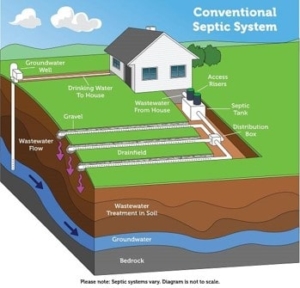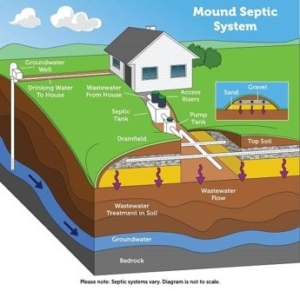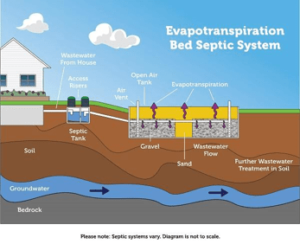9 Types of Septic System Installations Offered By The Plumbing Pro
According to the EPA website there are 9 typical types of septic wastewater treatment systems. All dwellings need systems to move wastewater and sewage. Some use the local sewer systems while others use a private self-contained wastewater and sewage treatment system (Septic).
No matter what the design of the septic system, the objective is to remove waste from the home, treat it and maintain environmental integrity of the location.
In the Kansas City Metro area, The Plumbing Pro will most often suggest the use of the first five types of septic systems. In order to inform you fully on all the systems, we are also sharing the four other types of systems listed on the EPA’s website as well.
Gravity Septic and Lateral Lines
Gravity Septic is a wastewater system that uses gravity move effluent (wastewater and sewage in liquid form) away  from the home to the septic and then onto the drain field (lateral lines.)
from the home to the septic and then onto the drain field (lateral lines.)
These systems move one gallon of waste away from the septic tank toward the drain field for every gallon of waste that enters the tank. This is called gravity flow. A gravity flow system does not use a pump to move the wastewater. Regular maintenance is required.
Gravity Septic and Lateral Lines can be designed using both
- Conventional
A conventional system is a decentralized wastewater treatment system is most often installed in a single-family home. It consists of a septic tank, access riser, distribution box, and a shallow GRAVEL lateral field. Effluent is moved by the system, treated by microbes and filtered through the gravel and soil.
- Infiltrator (Chamber)
An Infiltrator (Chamber) system does not use gravel. It is a gravel-less system. The advantage to an infiltrator system is easy of delivery and installation. However more importantly, they are best used in areas with high ground water or on systems where the volume of influent does not remain constant such as in vacation or seasonal homes. In the Infiltrator system the wastewater comes directly into contact with the soil where the effluent is treated by microbial action.
Low Pressure System
A low-pressure septic system is more of a managed system. It uses a septic tank, pump tank, and a pressure adjusting valve to move effluent into the distribution system. This system is great for clay and shallow soils.
Pond Septic System
A residential lagoon system may use a conventional septic tank, but effluent from the tank flows to a storage pond or lagoon for further treatment. (Some states such as Missouri may permit a lagoon without a septic tank.) A pond septic system is often used in rural areas and small farms.
They can be found with two different treatment system designs – aerobic and anaerobic. Aerobic uses a shallow pond and adding air to the water to speed treatment process. Anaerobic ponds are deeper and work much more like a traditional septic tank dividing the waste into settled sludge and treated effluent. Regular maintenance is required.
Mound Septic System
Mound septic systems in the Kansas City area are rare. They are useful in areas of shallow soil death, high groundwater or  shallow bedrock. They include a septic tank and is pump into the mound often in per-determined amounts. The effluent then filters through the mound.
shallow bedrock. They include a septic tank and is pump into the mound often in per-determined amounts. The effluent then filters through the mound.
A mound septic system can require more space and more maintenance than other systems.
Drip Irrigation Septic System
Drip irrigation septic system are often found in all kinds of properties, homes, farms, facilities and golf courses. They tend to use a shallow drain field that drips out over a wide area. This drainage can often be placed around trees, shrubs and other landscaping through flexible piping.
The advantage of this type of system is it require only 6 to 8 inches of soil, the disadvantage however is that it does require a larger dose tank attached to the septic tank and more piping. Regular maintenance is required.
Aerobic Treatment Unit
These septic systems are designed along the lines of a municipal sewage plant only on a far smaller scale. Aerobic Treatment Units inject oxygen into the septic system which increases the bacterial activity in the system. Improving treatment of wastewater.
These systems can be used in smaller lots and areas with inadequate soil for other systems. They do require regular maintenance.
Recirculating Sand Filter System
Sand filter are not often found her in the Kansas City area. They consist of a septic tank, a pump chamber and sand filters. This sand filter is either a box or PVC lined piping filled with sand. The wastewater is then pumped through these filters under low pressure to treat it.
They are good for areas with high water tables or when close to water bodies like lakes, oceans. A sand filter septic system is usually more expensive than standard septic systems.
Evapotranspiration System
These systems are unique and work in a way. Because evaporation is used, along with a drain field lined with watertight  material. Unlike most septic systems wastewater (effluent) never filters through the soil, it only evaporates into the air. These systems are found in climates that are arid and have ample sunlight and heat. Regular maintenance is required.
material. Unlike most septic systems wastewater (effluent) never filters through the soil, it only evaporates into the air. These systems are found in climates that are arid and have ample sunlight and heat. Regular maintenance is required.
Constructed Wetland System
A constructed wetland system is designed to work like natural wetlands. Wastewater flow in from the septic tank, passes through the plants, rocks, sand, gravel and soil where it is treated by the naturally occurring microbes.
These systems can be fed via gravity or pressure distribution. Regular maintenance is required.

 The Plumbing Pro 2019
The Plumbing Pro 2019 The Plumbing Pro
The Plumbing Pro